Laying Tiles in the Bathroom

In the bathroom repairs are not made so often, because the annual replacement of tiles is a very energy-consuming and troublesome affair. It is much easier and more profitable to think in advance about the original version of the tile layout, so the room will please you for several years.
Tips on Choosing Tiles
Tile is a modern finishing material for the bathroom. And the matter is not so much in its aesthetic qualities, as in the advantages over other materials. Ceramic tile is resistant to bacteria and dust, it is easy to clean, in addition the range of tiles in stores today is the greatest variety. In addition, it has a very low electrical conductivity, which is very important for rooms that are always wet.

Today you can see a huge variety of ceramic tiles on the shelves, but not every model is suitable for bathroom renovation. This is due to the fact that there is no universal tile suitable for finishing any surface. Therefore, when choosing a finishing material, you need to pay attention to the data available on the product label.
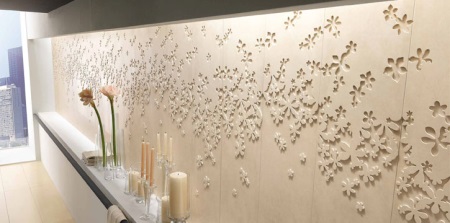
Indicators
Choosing tiles for the bathroom, consider the following indicators.
Moisture absorption
Since the bathroom is a room where humidity is always high, it is extremely important to choose a water-resistant material for tiling, which over time will not lose its attractive appearance.
According to the ability to absorb moisture, all ceramic tiles are divided into 8 groups. To repair the bathroom, you need to choose tiles belonging to the 1st, 2nd or 3rd group. Group 4 and all other groups following it are characterized by high porosity and are not suitable for damp rooms.
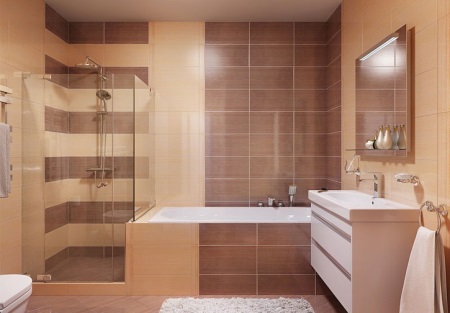
Resistance to chemicals
Since the bathroom needs to be cleaned quite often, the tiles will in any case be exposed to all kinds of cosmetic products. The ability of the tile surface to withstand the effects of household chemicals is marked with Latin letters. For the bathroom, tiles marked "AA" are ideal.
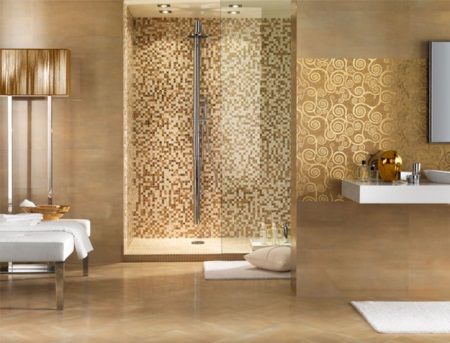
Purpose of tiles
Based on the purpose for which tiles are used, there is a material that deals exclusively with walls, and the material for the floor. The first is marked with a pictogram in the form of a picture of the palm.
Tile for the floor is different pictogram in the form of a pattern of the foot and also divided into classes, depending on the level of abrasion resistance. As you know, the home bathroom is usually used by a very small number of people, so it will be enough to buy a tile of the 2nd class of resistance (marked "PEI II").
There is no need to buy material that is more resistant to abrasion - the higher the strength class, the higher the price. You can see the symbols for these and other scribes in the illustration below.

Shape and design
To decide on the size of the tiles, you have to rely not only on your taste, but also on the fact that large tiles are only suitable for spacious rooms, while small tiles are perfect for curved surfaces.
With regard to texture, glossy tiles are excellent for small rooms, because it can visually make them more spacious.
But matte tile also has a number of advantages: it is not as noticeable as dirt and flaws. Regarding the color of the material, here it is necessary to trust your own taste. But many designers recommend calm, light colors as a base. Tiles with saturated colors is more appropriate to use for the arrangement of accents.
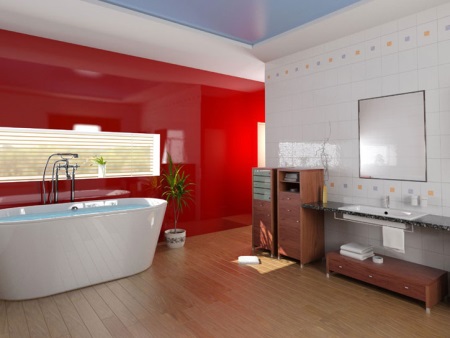
Read more in our article about Ways to decorate your bathroom with tiles.
Tile combinations
There are a lot of options for laying tiles. Each of them has its own advantages. Let's look at the main types.
Straight
The most common and at the same time the easiest way of laying tiles is straight - The tiles are parallel to the floor, ceiling and walls. For this variant is suitable and square tiles, and rectangular.
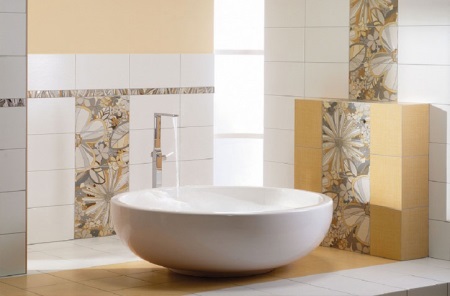
Tile overlap
Arrangement in a row is used when the effect of imitation brickwork should be achieved. It will look especially advantageous when the width of the tiles is half its length.
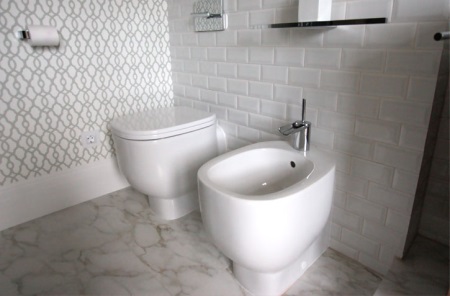
Diagonal
The most difficult variant of laying is diagonal. Here it is necessary quite often to cut the tile, so, not having the appropriate skills, to take on such a process should not. Laying "on the diagonal" - a more beautiful and spectacular way of laying tiles, compared to the previous, but also more difficult to perform. Its peculiarity is that the tile rows should not run parallel to the wall surface, but at an angle (usually 45°).
Diagonal laying is not suitable for every room. So, for example, in a small area, it is better not to use it, because it will visually reduce the room and emphasize all its shortcomings. And for large bathrooms, a tile laid diagonally can create a real miracle.
If you choose the right tile texture and pattern, it will be easy to highlight the decorative elements you need; besides, with the right color you can hide any layout flaws.
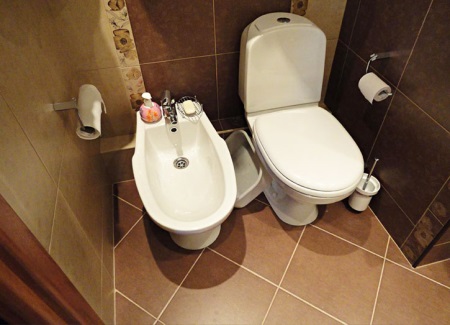
Modular
If tiles of different sizes are used, this type of laying is called "modular". It is with this method that it is possible to form an unusual pattern.
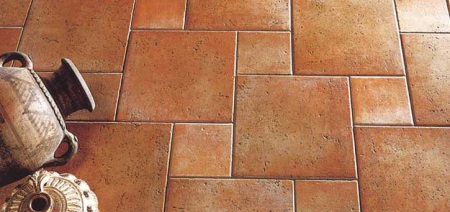
Artistic
The real top of skill - artistic laying, combining straight and diagonal, as well as tiles of different colors.
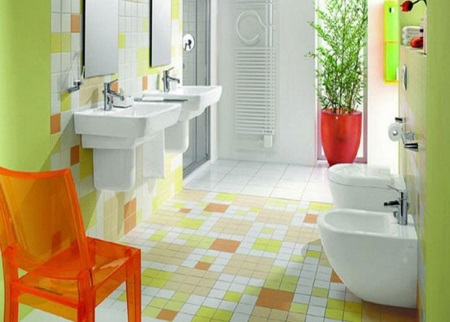
Horizontal
Another popular method of tile layout is the so-called "horizontal", which is a combination of a dark bottom and a light top. A border (usually one-color) is used as a transition from dark tiles to light ones. Usually, to give the space of the room a finished look, the same border is also laid under the ceiling. It is very important to use with this method of laying a monochrome tile without drawings and decorations.
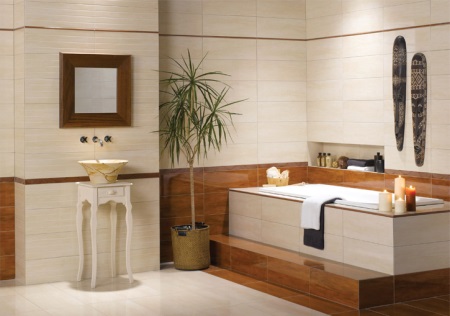
Vertical
"Vertical" variant of tile layout is distinguished by the fact that the strip of bright, distinguished tiles should go from the wall to the floor. It is this solution is currently at the height of fashion. Through this clever method, the height of the bathroom is increased. And if you highlight with this contrasting stripe any significant, in your opinion, elements of the interior, the room will undoubtedly be transformed.
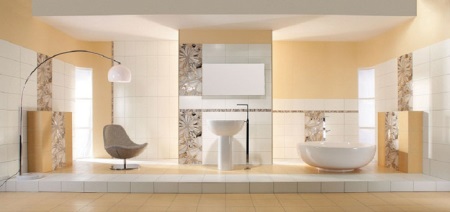
Zoning the bathroom with tiles
Bathroom zoning can rightly be called a necessity in any apartment, because when buying a house, people recently prefer to stay with the free layout - this allows them to implement the zoning of the room themselves.
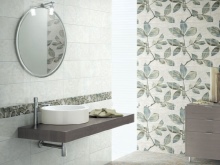
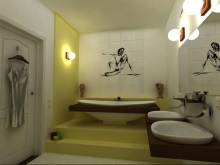
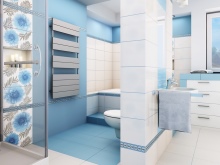
One of the most effective varieties of bathroom zoning is considered to be color zoning. To do this, you need to choose one collection of tiles and, accordingly, do the layout by color. Colors can be very diverse - bright, juicy, contrasting, or you can choose tones of the same color. With their help, it is quite possible to organize a whole composition - for example, "set" the bathtub on a podium, which is decorated with the same tiles as the walls of the room.
If the interior has an expensive plumbing, you can make an accent on it, "placing" it on the tile, which was not used in the finishing. In this way in general, you can highlight any element of the interior, worthy, in your opinion, of attention.
Tips for choosing tiles
Small Bathroom
Choosing tiles for a small bathroom, experts advise to opt for tiles of small size of dim, gentle tones. Very well suit the tile-mosaic, which can visually expand the space. However, if you still prefer saturated colors, it is best to combine light tiles with more lush shades.
To create the illusion of a large room, there is a very effective method - a light strip, which will "go" in the middle of the bathroom, as if dividing the space.
Remember that tiles of light colors will always visually increase the size of the room, and darker shades - on the contrary, reduce it. Even if you want to combine light and dark shades, the first should prevail. Floor tiles are also better to choose light colors.

Since mirrors also help to visually enlarge the space, it makes sense to use mirrored tiles.
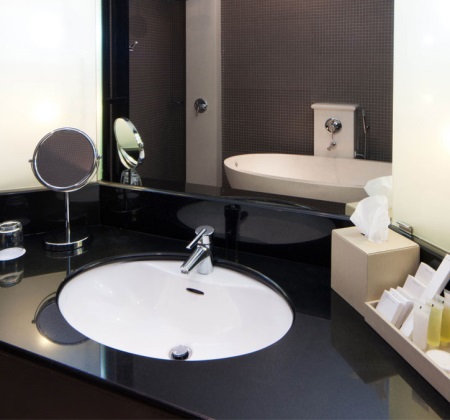
Low ceilings
For rooms with low ceilings, it is best to choose a vertical tile laying of light colors - verticals will "pull" the room, and the light color, as mentioned earlier, visually expands the space.

Popular laying options
There are several options for laying tiles. Consider the main ones.
Seam to seam
The simplest basic scheme is called "seam to seam" or "straight rows". The rows of tiles should go exclusively horizontally, level. At the same time, the tiles should be the same size or with a minimum variation in size.
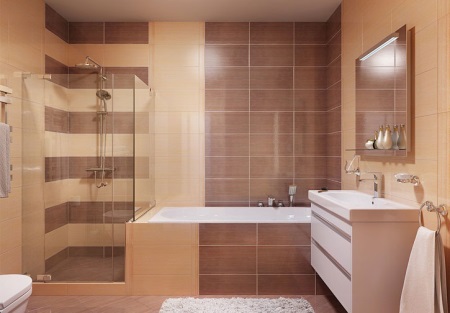
Checkerboard
Another method of laying is "checkerboard", which is a variation on the theme of "seam in seam", but using tiles of two different colors.

Tile-by-tile
Laying "tie-in" is very similar to masonry. It is done in the following way: in each successive row, each tile is positioned so that the middle of it was over the joint in the row lying below. Unlike the previous type, this method is implemented only in horizontal rows and allows some variation in the size of tiles.
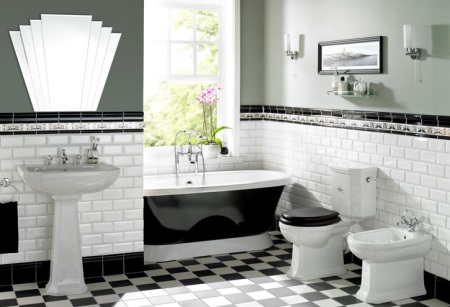
Modular
The modular method of laying tiles consists of using 3 or more multi-format types of tiles, thanks to which you can create a dynamic pattern. It can be anything: the inclusion of bright details in a monotone plane, a clear pattern, etc. This method requires the layout of materials without gluing.
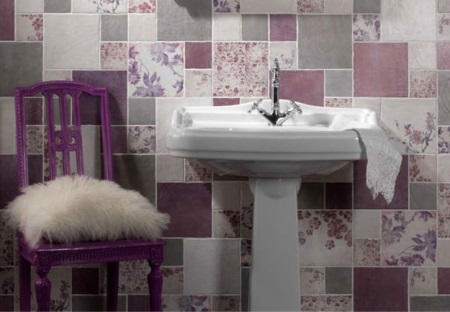
Drawing the plan
To choose a spectacular pattern, you need to consider many factors: the shape and size of the bathroom, as well as the type of tile used. But before you think about how best to lay tiles in the bathroom, you need to make a plan of the room - draw on paper approximately, but observing the proportions, your bathroom. Make a sketch larger to take into account the placement of the smallest details.
Next, use a tape measure to measure the width and height of your bathroom, the size of the doorway, the niche, etc. All measurements should be marked on the drawing. Do not forget to also note on the sketch the plumbing fixtures you are going to place and their dimensions. Then compare the resulting schematic drawing with the actual room. Remember that the consequences of miscalculation of even a couple of centimeters can consist in the fact that a beautiful tile element will be closed, and then your many efforts will be wasted.
Calculating the required number of tiles
Since tile - the material is far from cheap, you need to accurately calculate the necessary amount of it for the repair to avoid unnecessary waste. To do this you need to measure the surface, which is expected to tile. Knowing the length and height of the walls, you can easily calculate the area of the walls and floor. And by dividing this value by the area of one tile, you will know the number of tiles in pieces. But keep in mind that a stock of tiles never hurts - some tiles may have to be cut and some may get damaged or broken in the process.
Read more in our article on Calculating the Number of Tiles in the Bathroom.

After completing the repair and installing all the necessary plumbing, all that remains is to put the finishing touches and add a twist to the interior.
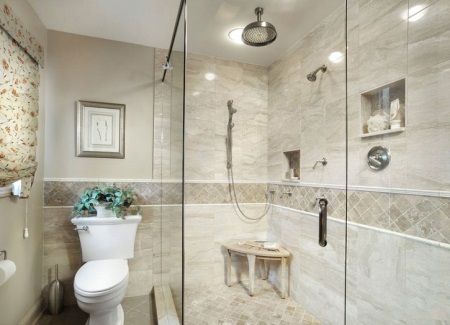





Artistic tile layout is an interesting option! That's probably the one I'm going to stop on.